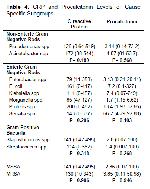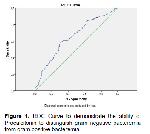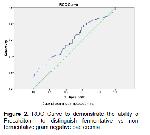In this study, we aimed to search for a possible role of two different biomarkers in predicting the microbiological agent which is responsible of bacteremia with a reasonably high number of episodes. Our data indicates that a procalcitonin level, which was drawn simultaneously with blood culture, higher than 4.055 was significantly associated with BSIGN with a sensitivity of 58.8% and a specificity of 69.9%. Furthermore, a procalcitonin level of 35.21 or higher was significantly associated with BSIE. While waiting for blood culture results it would be reasonable to put the patients, who has a high procalcitonin level, on antibiotics which have high Gram-negative coverage if clinically indicated.
Previous studies showed that procalcitonin is highly effective in diagnosing sepsis. Procalcitonin was also a significant biomarker to exclude bloodstream infections regardless of pathogen categories 12.
While being a useful tool in diagnosing sepsis and excluding blood stream infections, a certain cut off value was not established considering the heterogeneity and variations in recent studies. A recent meta-analysis showed that procalcitonin had a mean sensitivity and specificity of 0.77 and 0.79, respectively, for the diagnosis of sepsis 13. Oussalah et al. 13 reported an optimal procalcitonin thresholds ranging from 0.4 to 0.75 ng/mL had very high diagnostic accuracies for excluding all pathogen categories with the following negative predictive values; Gram-negative bacteria (98.9%) (including Enterobacteriacae (99.2%), non-fermentative Gram-negative bacilli (99.7%), and anaerobic bacteria (99.9%)), Gram-positive bacteria (98.4%), and fungi (99.6%). In their paper, they have reported different median procalcitonin levels among different pathogen groups. Procalcitonin levels above 10 ng/mL were associated with a high risk of BSIGN and BSIGP but also dramatically reduced the risk of potential contaminants found in blood cultures (PCBCs) or fungemia. Median procalcitonin levels were 2.2 (0.6-12.2), 2.5 (0.7-13.5), 1.1 (0.3-8.1), 2.7 (0.7-13.0) and 1.3 (0.3-6.9) for Gram-negative, Enterobacteriacae, Non-Enterobacteriacae, anaerobic bacteria, Gram-positive pathogen groups respectively. In our study the median procalcitonin levels were 5.59 (0.07-749), 6.49 (0.07-749), 3.6 (0.1-73.2) and 1.51 (0.07-100) for Gram-negative, Enterobacteriacae, non-Enterobacteriacae and Gram-positive pathogen groups respectively. Recently, Guo et al. 14 also have tried to investigate the usefulness of measuring procalcitonin to predict blood culture in septic patients. According to blood culture classifications, a significantly higher value of procalcitonin was observed in BSIGN bacteria (26.7 ng/mL, 0.09-188.3) than that in BSIGP bacteria (0.84 ng/mL, 0.05-18.79) or Candida spp. (1.12 ng/mL, 0.07-49.68). A cutoff value of ≥ 3.39 ng/mL for PCT showed a sensitivity of 80%, a specificity of 71%, a positive predictive value of 35%, a negative predictive value of 91% and an area under the curve of 0.73 for gram-negative bacteremia identification by BC. Among the 122 diagnostic episodes with positive blood culture results, a cutoff value of ≥ 6.47 ng/mL for PCT yielded a sensitivity of 74%, a specificity of 81%, a positive predictive value of 82%, a negative predictive value of 75% and an area under the curve of 0.81 for BSIGN identification. There have been reports indicating some different thresholds regarding procalcitonin level in order to distinguish gram negative bacteremia from gram positive bacteremia, which included smaller sample sizes in the literature 15-17. It has been shown that Gram-negative bacteria tend to induce higher levels of procalcitonin when compared with Gram-positive bacteria. Gram-negative infections probably increase proinflammatory cytokines like TNF alfa, IL 1, IL 6, IL 10 and IL 8, which may be explained by lipopolysaccharide, the major component of outer membrane, pattern activate neutrophils through the Toll-like receptor (TLR)-4. TLR activation triggers inflammatory cascades leading to synthesis of proinflammatory cytokines and acute phase proteins. Previous clinical and animal studies also have confirmed that a straight lipopolysaccharide injection induced production of procalcitonin. Our results also documented Gram-negative bacteria were associated with significantly higher procalcitonin levels when compared with Gram-positive bacteria.
Our study had several limitations. First, clinical outcome was not an endpoint regarding the study design. Benefit of implementing a clinical strategy based on certain thresholds of procalcitonin levels in managing bacteremia was not assessed. So, it is not possible to address if a strategy based on procalcitonin levels should decrease unnecessary antibiotic prescription rates or should decrease antibiotic resistance. Retrospective study design was another limitation. Also, we did not group patients according to the severity of infectious episode using a disease severity index. We have collected data of patients with BSI, sepsis and septic shock. We also did not include patients with fungemia. It would be reasonable to compare procalcitonin levels of patients with bacteremia and fungemia. A prospective study addressing all these limitations could further demonstrate the importance of procalcitonin on clinical judgment.
As a conclusion our findings suggest that level of PCT may predict whether Gram-negative bacteremia or a Gram-positive bacteremia. In this study PCT levels >4.055 ng/mL may be evidence of BSIGN and a cue for starting antibiotic treatment for Gram-negative bacteria. PCT levels >35.21 ng/mL likely indicates blood stream infection due to Enterobacteriaceae.








